2016 Hyundai Santa Fe 4WD
[x] Cancel search: 4WDPage 491 of 699
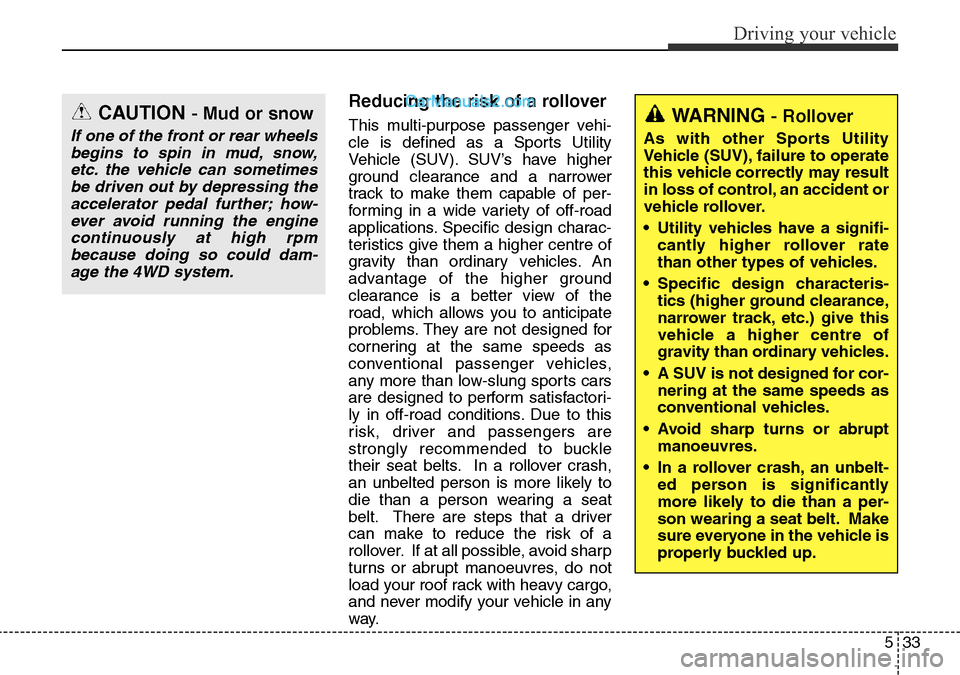
533
Driving your vehicle
Reducing the risk of a rollover
This multi-purpose passenger vehi-
cle is defined as a Sports Utility
Vehicle (SUV). SUV’s have higher
ground clearance and a narrower
track to make them capable of per-
forming in a wide variety of off-road
applications. Specific design charac-
teristics give them a higher centre of
gravity than ordinary vehicles. An
advantage of the higher ground
clearance is a better view of the
road, which allows you to anticipate
problems. They are not designed for
cornering at the same speeds as
conventional passenger vehicles,
any more than low-slung sports cars
are designed to perform satisfactori-
ly in off-road conditions. Due to this
risk, driver and passengers are
strongly recommended to buckle
their seat belts. In a rollover crash,
an unbelted person is more likely to
die than a person wearing a seat
belt. There are steps that a driver
can make to reduce the risk of a
rollover. If at all possible, avoid sharp
turns or abrupt manoeuvres, do not
load your roof rack with heavy cargo,
and never modify your vehicle in any
way.CAUTION - Mud or snow
If one of the front or rear wheels
begins to spin in mud, snow,
etc. the vehicle can sometimes
be driven out by depressing the
accelerator pedal further; how-
ever avoid running the engine
continuously at high rpm
because doing so could dam-
age the 4WD system.
WARNING - Rollover
As with other Sports Utility
Vehicle (SUV), failure to operate
this vehicle correctly may result
in loss of control, an accident or
vehicle rollover.
• Utility vehicles have a signifi-
cantly higher rollover rate
than other types of vehicles.
• Specific design characteris-
tics (higher ground clearance,
narrower track, etc.) give this
vehicle a higher centre of
gravity than ordinary vehicles.
• A SUV is not designed for cor-
nering at the same speeds as
conventional vehicles.
• Avoid sharp turns or abrupt
manoeuvres.
• In a rollover crash, an unbelt-
ed person is significantly
more likely to die than a per-
son wearing a seat belt. Make
sure everyone in the vehicle is
properly buckled up.
Page 492 of 699
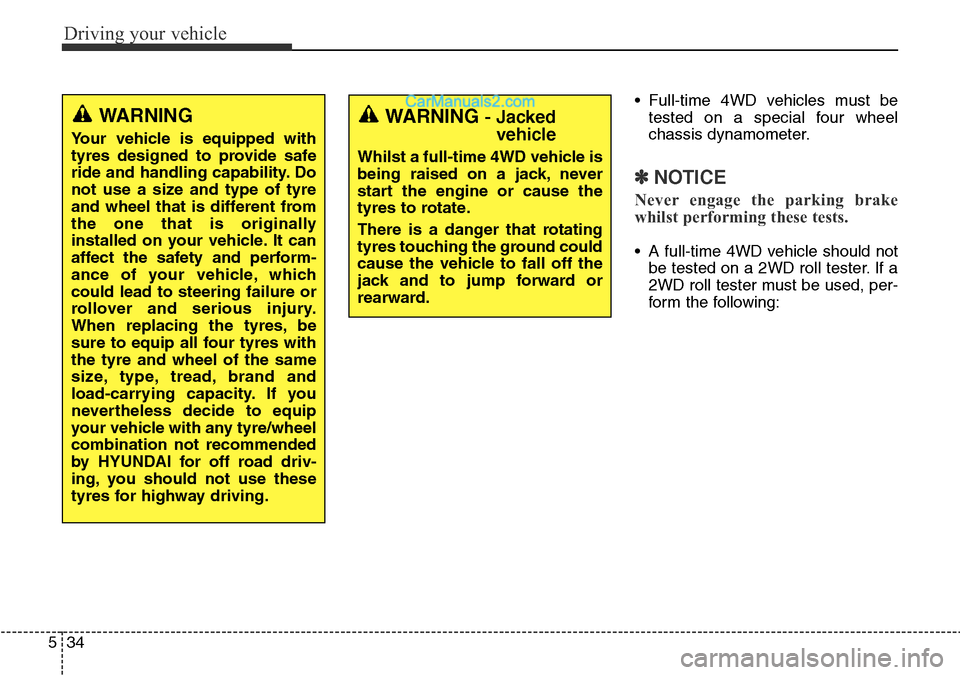
Driving your vehicle
34 5
• Full-time 4WD vehicles must be
tested on a special four wheel
chassis dynamometer.
✽NOTICE
Never engage the parking brake
whilst performing these tests.
• A full-time 4WD vehicle should not
be tested on a 2WD roll tester. If a
2WD roll tester must be used, per-
form the following:
WARNING - Jacked
vehicle
Whilst a full-time 4WD vehicle is
being raised on a jack, never
start the engine or cause the
tyres to rotate.
There is a danger that rotating
tyres touching the ground could
cause the vehicle to fall off the
jack and to jump forward or
rearward.
WARNING
Your vehicle is equipped with
tyres designed to provide safe
ride and handling capability. Do
not use a size and type of tyre
and wheel that is different from
the one that is originally
installed on your vehicle. It can
affect the safety and perform-
ance of your vehicle, which
could lead to steering failure or
rollover and serious injury.
When replacing the tyres, be
sure to equip all four tyres with
the tyre and wheel of the same
size, type, tread, brand and
load-carrying capacity. If you
nevertheless decide to equip
your vehicle with any tyre/wheel
combination not recommended
by HYUNDAI for off road driv-
ing, you should not use these
tyres for highway driving.
Page 542 of 699
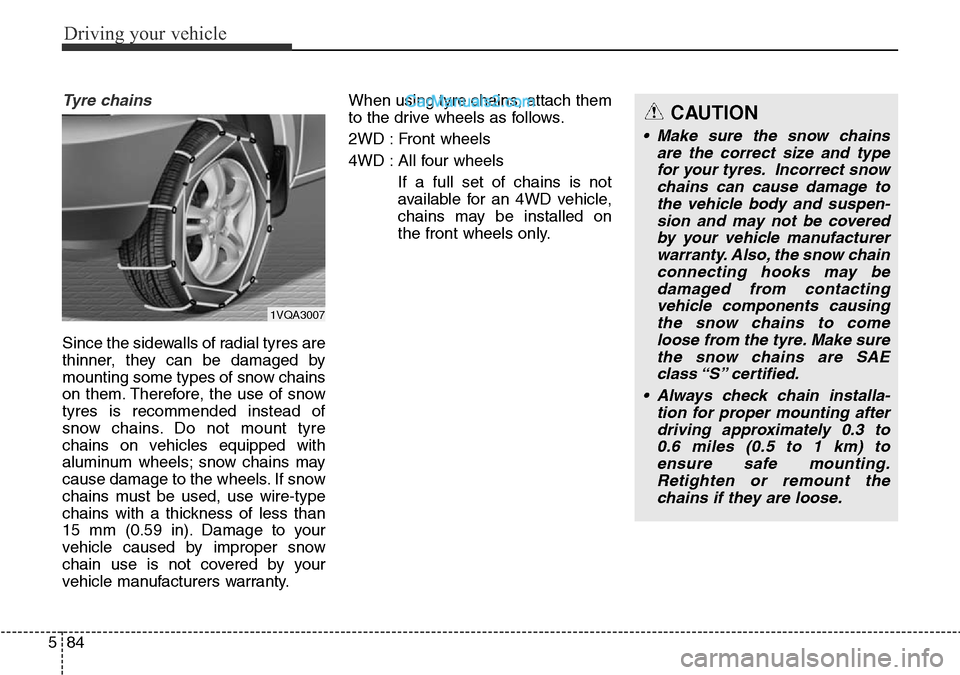
Driving your vehicle
84 5
Tyre chains
Since the sidewalls of radial tyres are
thinner, they can be damaged by
mounting some types of snow chains
on them. Therefore, the use of snow
tyres is recommended instead of
snow chains. Do not mount tyre
chains on vehicles equipped with
aluminum wheels; snow chains may
cause damage to the wheels. If snow
chains must be used, use wire-type
chains with a thickness of less than
15 mm (0.59 in). Damage to your
vehicle caused by improper snow
chain use is not covered by your
vehicle manufacturers warranty.When using tyre chains, attach them
to the drive wheels as follows.
2WD : Front wheels
4WD : All four wheels
If a full set of chains is not
available for an 4WD vehicle,
chains may be installed on
the front wheels only.
CAUTION
• Make sure the snow chains
are the correct size and type
for your tyres. Incorrect snow
chains can cause damage to
the vehicle body and suspen-
sion and may not be covered
by your vehicle manufacturer
warranty. Also, the snow chain
connecting hooks may be
damaged from contacting
vehicle components causing
the snow chains to come
loose from the tyre. Make sure
the snow chains are SAE
class “S” certified.
• Always check chain installa-
tion for proper mounting after
driving approximately 0.3 to
0.6 miles (0.5 to 1 km) to
ensure safe mounting.
Retighten or remount the
chains if they are loose.
1VQA3007
Page 593 of 699
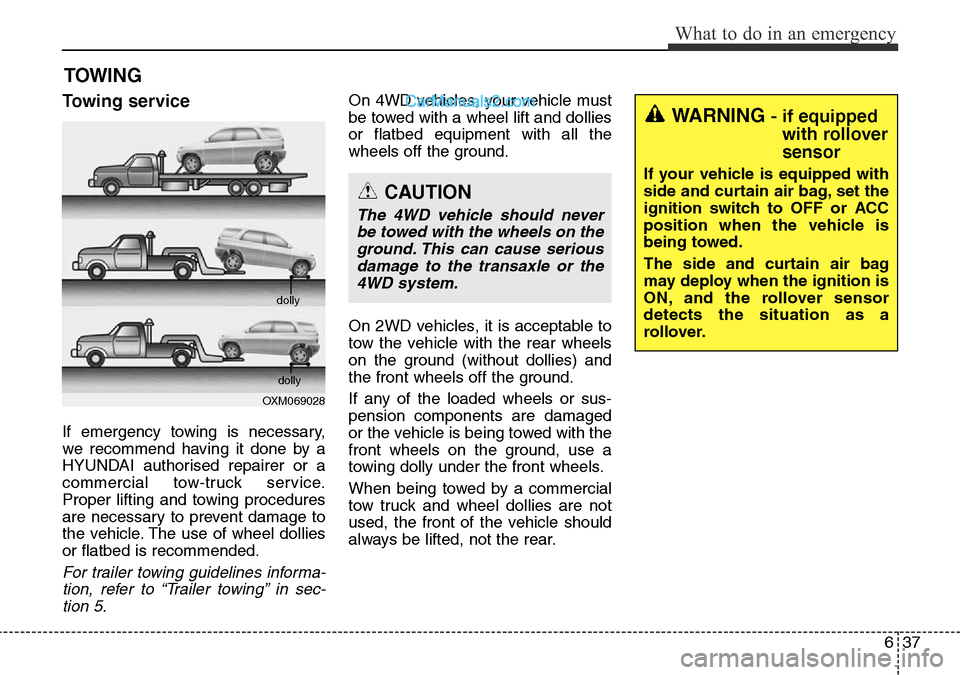
637
What to do in an emergency
TOWING
Towing service
If emergency towing is necessary,
we recommend having it done by a
HYUNDAI authorised repairer or a
commercial tow-truck service.
Proper lifting and towing procedures
are necessary to prevent damage to
the vehicle. The use of wheel dollies
or flatbed is recommended.
For trailer towing guidelines informa-
tion, refer to “Trailer towing” in sec-
tion 5.
On 4WD vehicles, your vehicle must
be towed with a wheel lift and dollies
or flatbed equipment with all the
wheels off the ground.
On 2WD vehicles, it is acceptable to
tow the vehicle with the rear wheels
on the ground (without dollies) and
the front wheels off the ground.
If any of the loaded wheels or sus-
pension components are damaged
or the vehicle is being towed with the
front wheels on the ground, use a
towing dolly under the front wheels.
When being towed by a commercial
tow truck and wheel dollies are not
used, the front of the vehicle should
always be lifted, not the rear.
OXM069028dolly
dolly
CAUTION
The 4WD vehicle should never
be towed with the wheels on the
ground. This can cause serious
damage to the transaxle or the
4WD system.
WARNING - if equipped
with rollover
sensor
If your vehicle is equipped with
side and curtain air bag, set the
ignition switch to OFF or ACC
position when the vehicle is
being towed.
The side and curtain air bag
may deploy when the ignition is
ON, and the rollover sensor
detects the situation as a
rollover.
Page 649 of 699

Maintenance
52 7
DescriptionSymbol Fuse ratingProtected Component
A/BAG IND10AInstrument Cluster
A/BAG15ASRS Control Module, A/C Control Module
MODULE 57.5A
Rain Sensor, Sunroof, Smart Key Control Module, BCM, Parking Guide System, AC,
Inverter Module, ICM Relay Box (Cornering Lamp Relay LH/RH, Rear Blower Relay),
Rear Seat Warmer LH/RH, Driver/Passenger Climate Control Seat Control Module,
Driver/Passenger Seat Warmer Module
MODULE 17.5ASport Mode Switch, Key Solenoid, Console Switch LH/RH, Front Console Switch,
Rear Power Window Switch LH/RH
REAR FOG LAMP10AICM Relay Box (Rear Fog Lamp Relay)
MEMORY 210ABCM, Tyre Pressure Monitoring Module, Driver IMS Module, Driver/Passenger Door
Module, Auto Light & Photo Sensor, Data Link Connector, A/C Control Module,
Instrument Cluster
SMART KEY 27.5ASmart Key Control Module, Immobiliser Module
MODULE 310A
BCM, Instrument Cluster, Tyre Pressure Monitoring Module, AMP, Smart Parking Assist
Control Module, Electro Chromic Mirror, Lane Departure Warning Module, Steering
Angle Sensor, A/C Control Module, A/V & Navigation Head Unit, 4WD ECM
ATM Shift Lever Indicator, Rear Parking Assist Sensor LH/RH, Rear Seat Warmer
LH/RH, Driver/Passenger Climate Control Seat Control Module, Driver/Passenger Seat
Warmer Module, Driver IMS Module, Console Switch LH/RH, Rear Console Switch,
Rear Parking Assist Sensor (Centre) LH/RH, Driver/Passenger Door Module, Electric
Parking Brake Module
SMART KEY 410AStart/Stop Button Switch, Immobiliser Module
Page 656 of 699
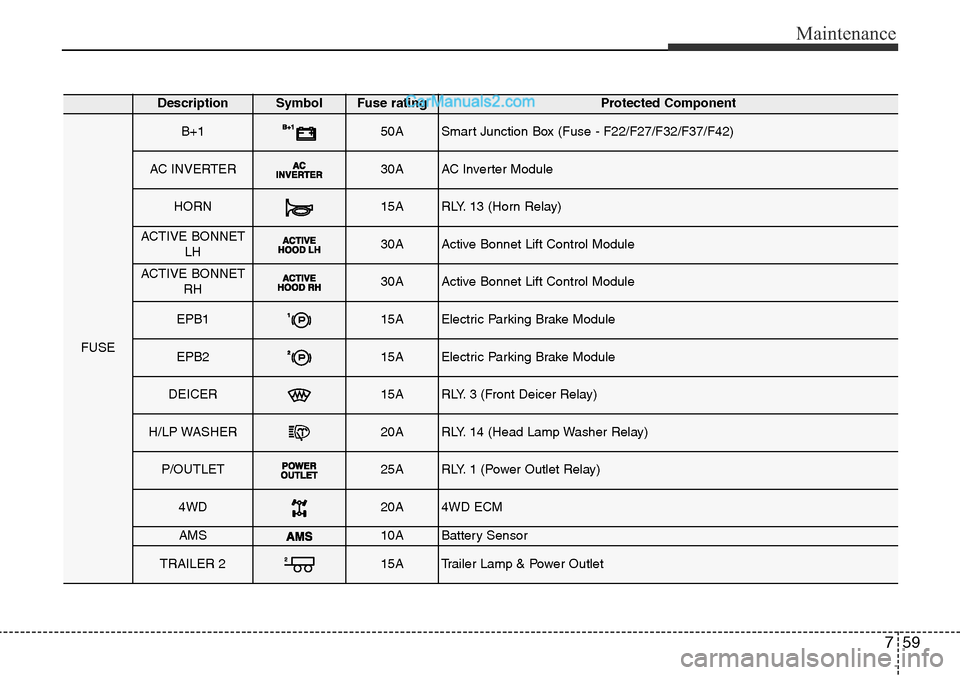
759
Maintenance
DescriptionSymbol Fuse ratingProtected Component
FUSE
B+150ASmart Junction Box (Fuse - F22/F27/F32/F37/F42)
AC INVERTER30AAC Inverter Module
HORN15ARLY. 13 (Horn Relay)
ACTIVE BONNET
LH30AActive Bonnet Lift Control Module
ACTIVE BONNET
RH30AActive Bonnet Lift Control Module
EPB115AElectric Parking Brake Module
EPB215AElectric Parking Brake Module
DEICER15ARLY. 3 (Front Deicer Relay)
H/LP WASHER20ARLY. 14 (Head Lamp Washer Relay)
P/OUTLET25ARLY. 1 (Power Outlet Relay)
4WD20A4WD ECM
AMS10ABattery Sensor
TRAILER 215ATrailer Lamp & Power Outlet
Page 693 of 699
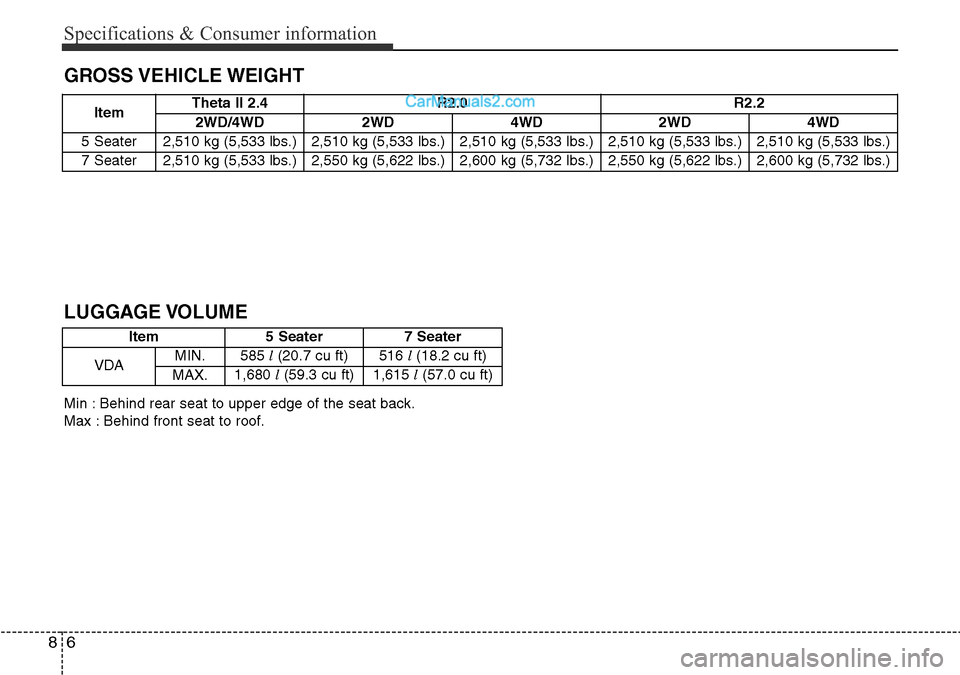
Specifications & Consumer information
6 8
GROSS VEHICLE WEIGHT
ItemTheta II 2.4 R2.0 R2.2
2WD/4WD 2WD 4WD 2WD 4WD
5 Seater 2,510 kg (5,533 lbs.) 2,510 kg (5,533 lbs.) 2,510 kg (5,533 lbs.) 2,510 kg (5,533 lbs.) 2,510 kg (5,533 lbs.)
7 Seater 2,510 kg (5,533 lbs.) 2,550 kg (5,622 lbs.) 2,600 kg (5,732 lbs.) 2,550 kg (5,622 lbs.) 2,600 kg (5,732 lbs.)
ltem 5 Seater 7 Seater
VDAMIN.585 l(20.7 cu ft) 516 l(18.2 cu ft)
MAX.1,680 l(59.3 cu ft) 1,615 l(57.0 cu ft)
Min : Behind rear seat to upper edge of the seat back.
Max : Behind front seat to roof.
LUGGAGE VOLUME
Page 695 of 699
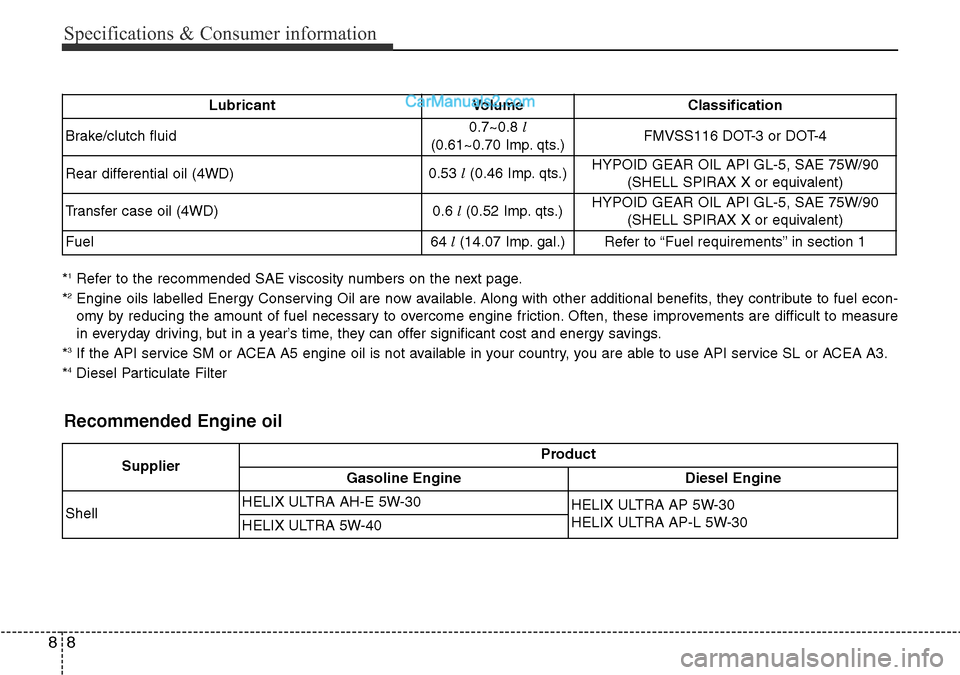
Specifications & Consumer information
8 8
*1Refer to the recommended SAE viscosity numbers on the next page.
*2Engine oils labelled Energy Conserving Oil are now available. Along with other additional benefits, they contribute to fuel econ-
omy by reducing the amount of fuel necessary to overcome engine friction. Often, these improvements are difficult to measure
in everyday driving, but in a year’s time, they can offer significant cost and energy savings.
*
3If the API service SM or ACEA A5 engine oil is not available in your country, you are able to use API service SL or ACEA A3.
*4Diesel Particulate FilterLubricant Volume Classification
Brake/clutch fluid0.7~0.8 l
(0.61~0.70 Imp. qts.)FMVSS116 DOT-3 or DOT-4
Rear differential oil (4WD)0.53 l(0.46 Imp. qts.)HYPOID GEAR OIL API GL-5, SAE 75W/90
(SHELL SPIRAX X or equivalent)
Transfer case oil (4WD) 0.6 l(0.52 Imp. qts.)HYPOID GEAR OIL API GL-5, SAE 75W/90
(SHELL SPIRAX X or equivalent)
Fuel64 l(14.07 Imp. gal.)
Refer to “Fuel requirements” in section 1
Recommended Engine oil
SupplierProduct
Gasoline Engine Diesel Engine
ShellHELIX ULTRA AH-E 5W-30
HELIX ULTRA AP 5W-30
HELIX ULTRA AP-L 5W-30
HELIX ULTRA 5W-40